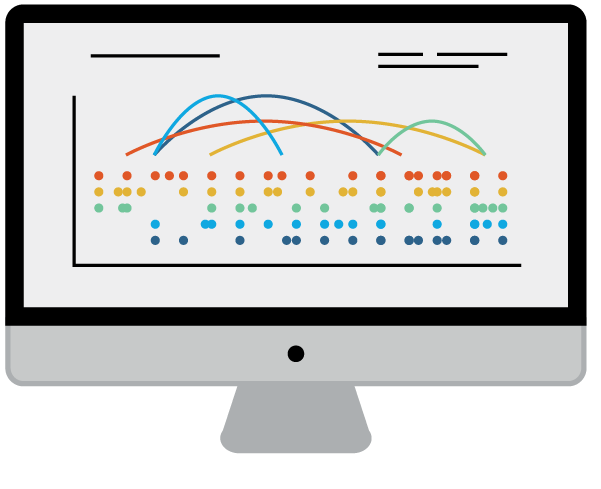
Research Interests

3D Chromatin Structure
In addition to the roughly 30,000 known human genes, the human genome harbors tens of thousands of enhancers, small genomic elements that can regulate the expression of genes that are several hundreds of kilobases away. This regulation is often carried out via DNA looping events that bring enhancers into close three-dimensional proximity with their target genes. Enhancer-mediated gene regulation is a widespread phenomenon that is known to modulate a variety of biological processes including human development, cancer progression, and response to environmental stress. However, while our ability to predict enhancers is fairly mature, we know little about the mechanisms governing loop-mediated gene regulation. We use a combination of high throughput genomic techniques (including Hi-C) to map and understand changes in 3D chromatin structures and characterize their effects on human health and disease.
Chromatin loop dynamics during cellular differentiation are associated with changes to both anchor and internal regulatory features. Bond M.L., Davis E.S., Quiroga I.Y., Kiran M, Love M.I., Won H, Phanstiel D.H. Genome Research, 2023.
Temporal analysis suggests a reciprocal relationship between 3D chromatin structure and transcription. Reed K. S. M.*, Davis E. S.*, Bond M. L., Cabrera A., Thulson E., Quiroga I. Y., Cassel S., Woolery K. T., Hilton I., Won H., Love M. I., Phanstiel D. H. Cell Reports, 2022.
Static and Dynamic DNA Loops form AP-1-Bound Activation Hubs during Macrophage Development.Phanstiel, D.H.*, Van Bortle, K.*, Spacek D.V., Hess G.T., Saad Shamim M., Machol I., Love M.I., Lieberman Aiden E., Bassik M.C., Snyder, M.P. Molecular Cell, 2017.

Human Genetics of Age-related Diseases
Genome-wide association studies (GWAS) have revealed how genetic variation contributes to risk for osteoarthritis (OA) and Alzheimer’s disease (AD), but most associated loci fall in non-coding regions. We apply high-resolution functional genomics approaches—including massively parallel reporter assays (MPRA), RNA-seq, and ATAC-seq—to pinpoint causal variants, identify their target genes, and elucidate mechanisms of disease pathogenesis.
Osteoarthritis: OA affects over 595 million individuals globally and serves as the leading cause of disability for adults; however, potential treatment options remain elusive because the mechanisms driving OA are largely unknown. We use integrated genomic profiling, MPRA, quantitative trait loci (QTL) mapping, and existing GWAS data to advance the understanding of OA biology, genetic risk, and targeted therapeutic development.
Alzheimer’s Disease: AD is the most common neurodegenerative disorder, affecting over 7 million Americans. Genomic analyses highlight the major role for immune cells in disease risk. We model AD in a dish using iPSC-derived microglia and cortical organoids and apply computational and experimental methods to identify AD risk variants and their effector genes.
Response splicing quantitative trait loci in primary human chondrocytes identify putative osteoarthritis risk genes Byun S, Coryell P, Kramer N, D'Costa S, Thulson E, Shine J, Parkus S, Chubinskaya S, Loeser RF, Diekman BO, Phanstiel DH Nature Comm.. 2025.
Response eQTLs, chromatin accessibility, and 3D chromatin structure in chondrocytes provide mechanistic insight into osteoarthritis risk. Kramer NE, Byun S, Coryell P, D'Costa S, Thulson E, Kim H, Parkus SM, Bond ML, Klein ER, Shine J, Chubinskaya S, Love MI, Mohlke KL, Diekman BO, Loeser RF, Phanstiel DH. Cell Genom. 2025.
Deciphering the functional impact of Alzheimer's Disease-associated variants in resting and proinflammatory immune cells.Bond ML, Quiroga-Barber IY, D'Costa S, Wu Y, Bell JL, McAfee JC, Kramer NE, Lee S, Patrucco M, Phanstiel DH, Won H. medRxiv [Preprint]. 2024.
3D Chromatin Regulation in Cancer
Oncogenic fusion proteins drive a wide array of aggressive cancers, often by hijacking the cell’s normal gene regulation. One emerging mechanism involves liquid–liquid phase separation—a biophysical process that reshapes the 3D structure of chromatin, the genetic material in our cells. Our research explores how oncogenic fusion proteins use phase separation to disrupt genome organization and gene expression, contributing to cancer development. We combine Hi-C, imaging, genomics, and functional screens to uncover how these proteins rewire the nucleus and identify new therapeutic vulnerabilities in fusion-driven cancers.
Oncogenic fusion proteins and their role in three-dimensional chromatin structure, phase separation, and cancer. Quiroga I.Y., Ahn J.H., Wang G.G., Phanstiel D.H. Current Opinion in Genetics & Development, 2022.
Phase separation drives aberrant chromatin looping and cancer development. Ahn H.A., Davis E.S., Daugird S.Z., Zhao S., Quiroga I.Y., Uryu H., Li J., Storey A.J., Tsai Y., Keeley, D.P., Mackintosh S.G., Edmondson R.D., Byrum S.D., Cai L., Tackett A.J., Zheng D., Legant W.R., Phanstiel D.H., Wang G.G. Nature, 2021.

Software Development
With the great increase in complexity of -omic technologies comes an even greater need for tools to help investigate and interpret the data. We develop R packages, web applications, and pipelines to analyze and visualize large multi-omic data sets. We aim to reduce data dimensionality into simple visualizations that improve interpretability. We work on open-source software to facilitate the analysis of genetic, genomic, and proteomic data. We aim to make the software, designed to address novel analysis problems arising from the needs of our experimental undertakings, widely accessible and generalizable to other scientists.
Plotgardener: cultivating precise multi-panel figures in R. Kramer NE, Davis ES, Wenger CD, Deoudes EM, Parker SM, Love MI, Phanstiel DH. Bioinformatics. 2022.
Coral: Clear and Customizable Visualization of Human Kinome Data. Metz KS, Deoudes EM, Berginski ME, Jimenez-Ruiz I, Aksoy BA, Hammerbacher J, Gomez SM, Phanstiel DH. Cell Syst. 2018.
Mariner: explore the Hi-Cs. Davis ES, Parker SM, Kramer NE, Flores JP, Kiran M, Phanstiel DH. Bioinformatics. 2024.

CULTIVATED MEAT
Beef production is a leading contributor to greenhouse gas emissions, deforestation, climate change, zoonotic disease risk, and animal suffering. Additionally, undercooked meat remains a major source of foodborne illness due to contamination with intestinal pathogens such as Salmonella, Escherichia coli, and Campylobacter. Cultivated meat produced in bioreactors rather than live animals was recently approved for sale in the United States and offers a promising solution to these challenges; however, current production methods remain technically limited and prohibitively expensive, restricting its widespread adoption.
Our lab uses high-throughput CRISPR screens, genome editing, and computational biology to develop novel animal cell lines that improve the health, safety, and cost-effectiveness of cultivated meat. Current projects include engineering bovine cells that lack alpha-gal epitopes, making them safe for patients with mammalian meat allergies (alpha-gal syndrome), and optimizing cellular properties to enhance growth efficiency and reduce production costs.